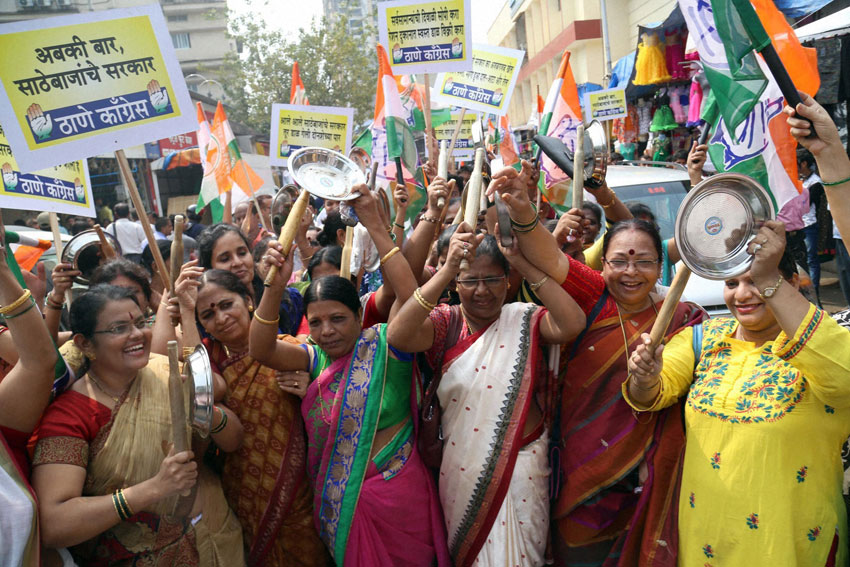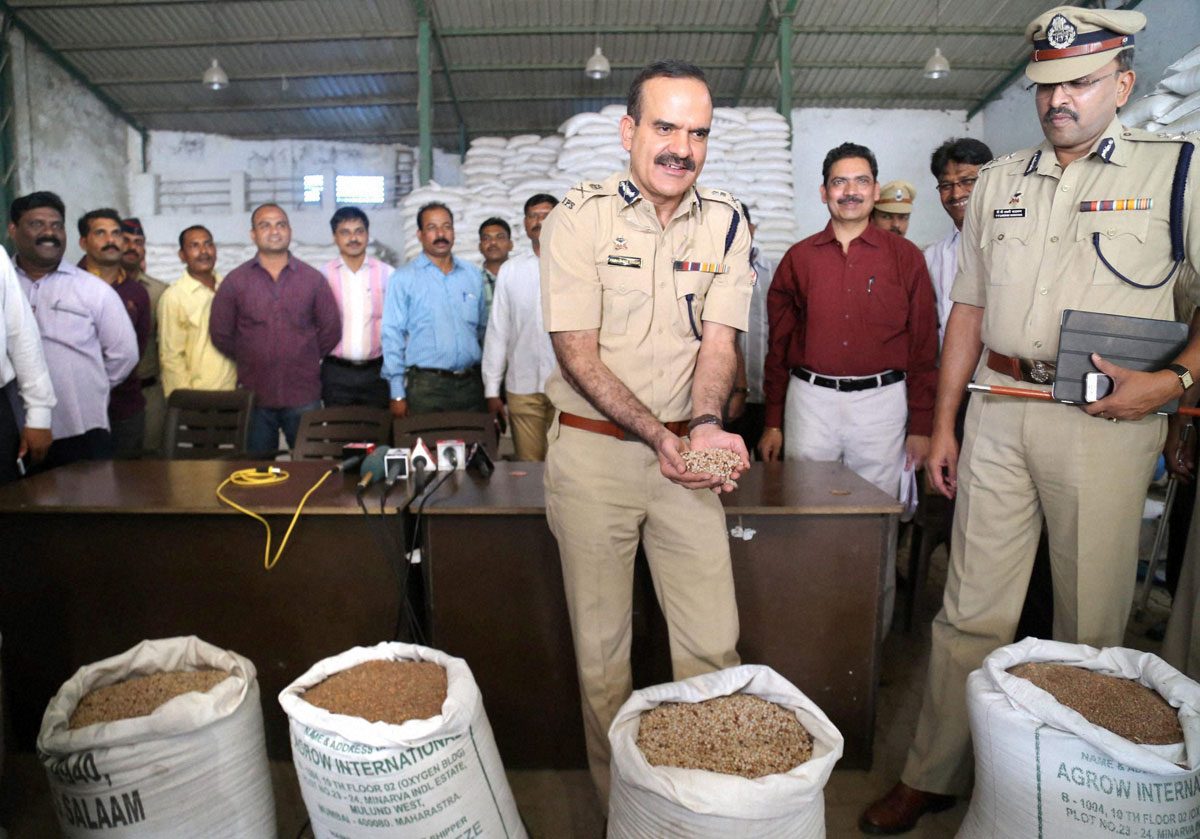SPIRALING LENTIL INFLATION
Crime Branch officers at a press conference after seizing 12,000 tons of pulses worth Rs. 112 crores, in Thane, Mumbai, Oct. 28. (Press Trust of India)
India’s pulse-rates have hit a never seen before high as the prices of this important dietary component, of the masses and classes alike, have risen by 100%, crossing the mark of Rs. 100 per kilogram for most pulses and Rs. 210 per kilogram in the case of “toor” or “arhar” (pigeon pea), writes Priyanka Bhardwaj.
Maintaining domestic expenditure within limits has led to people lowering their consumption of “daals” (pulses or lentils) or else substituting them, partly or entirely, with other sources of protein or amino acids or increasing their consumption of a variety of vegetables.
The data from the Consumer Affairs Ministry reveals that retail price of urad is at Rs 190/kg, moong dal Rs. 130/kg, masoor dal Rs 110/kg and gram Rs 85/kg.
And in the markets of Rajkot, Bangalore, Puducherry and Chennai, prices of “toor” have reached Rs. 200/kg (and even higher) — which means an annual increase of 100, 163, 147 and 141 percent, respectively.
Scrambling to avoid an imminent political danger in the Bihar assembly elections where the price rise turned into a major campaign theme, the ruling political dispensation has reacted with several anti-hoarding measures.
Memories are still afresh of the defeat of the Bharatiya Janta Party due to its inability to rein in the price rise of onions in the national capital, Delhi, many years back.
These measures include: institution of a committee; invoking of the Essential Commodities Act against traders and stockists (hoarders); setting of stocking limits on pulse-mills, large retailers, warehouses, etc; import of 7,000 tons of “toor” dal, annulling of the import duty on the commodity, banning of its exports, futures or forwards trading.
Still not much relief appears to be in sight and even by mid-November when the new crop is expected to hit the markets, predictions are that festivities will shoot up the demand and thus the prices.
India’s lag in cultivation of pulses stands at 12% or more than 2 million tons and imports almost 4-5 million tons every year.
Further, coupled with lower imports from Burma and a severe drought in the pulse-growing states of Maharashtra, Karnataka and Madhya Pradesh, supply pressures became worse, all of which were put to maximum advantage by traders and hoarders to jack up the prices while the government and bureaucracy remained in their characteristic lax state.
Even in the international markets the surplus in pulse is limited to around 13 to 15 million tons and if there is a slight rise in demand in India, global prices just zoom.
Assessing the stock and situation, Finance Minister Arun Jaitley concedes that the domestic and global scene are a story of rising costs of pulses and he added that the government has cracked down on hoarders, thus leading to 3,300 searchers and recovery of 50,000 tons of pulses in raids in over 10 states.
He said, “The raids will continue in the coming days. And the seized stock of pulses will be milled and offloaded in the market which will ease the prices of pulses in wholesale and retail market.”
To augment supplies and for distribution purposes the government has imported 5,000 tons of pulses.
India Pulses and Grains Association, the apex body of pulses and grains (IPGA) has said import of pulse is expected to touch 2,500,000 tons and would be primarily from Canada and the U.S.
If anti-hoarding laws are put into strict implementation, importers bear a worry that their stocks may be seized by the state governments.

The IPGA officials comment that importers, millers and transporters are unwilling to handle the imported stocks due to fear of government seizing the stocks and in this context the Chairman of IPGA, Pravin Dongre met with Jaitley to apprise him that, “Prices will come down only when the government allows pulses imports and importers to be exempted from stock holding limits. We would also like the government to give us 30 to 60 days’ time to liquidate the stocks held by us.”
Though the government appears to be patting its back with the promulgation of anti-hoarding drive, these actions only tend to destabilize legitimate stockists and millers who have pledged their commodities with the banks and cannot dispose off their stocks immediately on procurement.
What the government has overlooked is the reform of the Agricultural Produce Market Committee Act that is long overdue and putting in place certain infrastructure like modern farm storage spaces, cold chains and warehouses.
However much the government and political fraternity may choose to define the issue as an aberrant one, the problem seems here to stay and would require long term policies to ensure permanent plugging of the huge gap between demand and supply.
This would need bringing in more irrigated areas under cultivation of lentils, better seeds and pest control, well thought out support prices, streamlining of the entire supply chain and easy availability of crop loans.
The country’s consumption of lentils stands at 6,000 metric tons and reports have come in that “rabi” (winter crop sown in October and harvested in March) sowing area under pulses doubled to 0.98 million hectares from 0.47 million hectares during the corresponding period last year.
Revamping ports to handle imports and transport to the interiors is another thing and recently Adani Ports and Special Economic Zone inked a MoU with the India Pulses and Grains Association to develop “a dedicated and efficient supply chain for pulses, using strategically located Adani Ports’ facilities to all main consumption centers in the country.”
With a quarter of the world’s hungry—195 million out of 795 million globally residing in India and high incidence of protein malnourishment among children under five (every second child has a low height for their age as per the National Family Health Survey data of 2005-06) neither the government nor can its people look over the problem of price rise in pulses and food inflation in any hurry.


